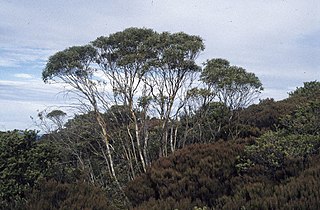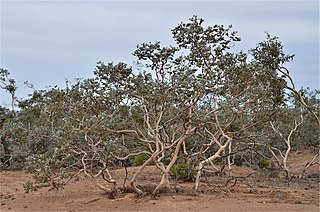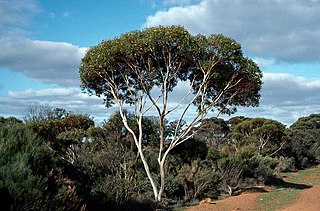
Eucalyptus melanophloia, commonly known as silver-leaved ironbark, is a species of tree that is endemic to northeastern Australia. It is a small to medium-sized tree with rough, hard ironbark on the trunk and branches. The crown is usually composed of juvenile leaves that are dull, glaucous, sessile and arranged in opposite pairs. The flower buds are arranged in groups of seven, the flowers white and the fruit cup-shaped to hemispherical.

Eucalyptus rubida, commonly known as candlebark, ribbon gum or white gum, is a species of small to medium-sized tree that is endemic to south-eastern Australia. It has smooth bark, sometimes with rough bark at the base, lance-shaped or curved adult leaves, flower buds in groups of three, white flowers and cup-shaped, hemispherical or bell-shaped fruit.

Eucalyptus todtiana, commonly known as coastal blackbuttpricklybark or dwutta, is a species of tree or a mallee that is endemic to the west coast of Western Australia. It has rough, fibrous and flaky bark on the trunk, smooth bark on the branches, lance-shaped adult leaves, flower buds in groups of between seven and eleven, white flowers and cup-shaped to hemispherical fruit.

Eucalyptus globulus subsp. bicostata, commonly known as the southern blue gum, eurabbie, blue gum or Victorian blue gum, is a subspecies of tree that is endemic to south-eastern Australia. It has mostly smooth bark with some persistent slabs of old bark at the base, juvenile leaves with one glaucous side, glossy, lance-shaped adult leaves, warty flower buds in groups of three, white flowers and hemispherical to conical fruit.

Eucalyptus notabilis, commonly known as Blue Mountains mahogany or mountain mahogany, is a species of small to medium-sized tree endemic to eastern Australia. It has rough, fibrous bark on the trunk and branches, lance-shaped to curved adult leaves, flower buds in groups of between seven and eleven, white flowers and hemispherical or conical fruit.

Eucalyptus imlayensis, commonly known as the Mount Imlay mallee, is a species of small, straggly mallee that is endemic to the far south east of New South Wales, only occurring near the summit of Mount Imlay. It has mostly smooth bark, lance-shaped to curved adult leaves, flower buds in groups of three, white flowers and cup-shaped, bell-shaped or hemispherical fruit.

Eucalyptus moorei, commonly known as narrow-leaved sally, is a species of mallee that is endemic to New South Wales. It has smooth bark, linear to narrow lance-shaped or curved adult leaves, flower buds in groups of between seven and fifteen, white flowers and cup-shaped or shortened spherical fruit.

Eucalyptus kybeanensis, commonly known as the Kybean mallee ash, is a species of mallee or tree that is endemic to south eastern Australia. It has smooth, white or greyish bark, lance-shaped adult leaves, flower buds in groups of seven, nine or eleven, white flowers and conical or hemispherical fruit.

Eucalyptus gillii, known as the curly mallee, Arkaroola mallee, or silver mallee, is a species of mallee or small tree that is endemic to inland Australia. It has smooth bark, sometimes with rough bark near the base, often only juvenile, usually glaucous leaves in the crown, flower buds in groups of between seven and eleven, pale yellow flowers and barrel-shaped or shortened spherical fruit.

Eucalyptus subcrenulata, commonly known as Tasmanian alpine yellow gum, is a species of small to medium-sized tree that is endemic to the highlands of Tasmania. It has smooth bark, glossy green, lance-shaped to egg-shaped adult leaves, flower buds in groups of three, white flowers and hemispherical to bell-shaped fruit. It is similar to E. johnstonii, E. vernicosa and E. urnigera.

Eucalyptus albida, commonly known as the white-leaved mallee, is a mallee that is endemic to the south-west of Western Australia. It has smooth white or greyish brown bark, lance shaped adult leaves, and flowers in groups of between seven and eleven. The flowers are creamy white and the fruit are hemispherical to cone-shaped. The juvenile leaves that are often retained on mature plants are arranged in opposite pairs, egg-shaped to heart-shaped and bluish grey.

Eucalyptus jucunda, commonly known as Yuna mallee, is a species of mallee or small tree that is endemic to Western Australia. It has smooth bark, lance-shaped to curved adult leaves, flowering buds in groups of seven or nine, white or cream-coloured flowers and barrel-shaped or shortened spherical fruit with an unusually narrow opening.

Eucalyptus oldfieldii, commonly known as Oldfield's mallee, is a species of mallee or tree that is endemic to Western Australia. It has a sprawling or spreading habit, mostly smooth greyish or brownish bark, lance-shaped adult leaves, flower buds in groups of three, white flowers and conical, cup-shaped or hemispherical fruit.

Eucalyptus rigidula, commonly known as stiff-leaved mallee, is a species of mallee that is endemic to Western Australia. It has smooth bark, linear to narrow elliptic or narrow lance-shaped leaves, flower buds in groups of nine or eleven, creamy white flowers and barrel-shaped to hemispherical fruit.

Eucalyptus sessilis, commonly known as Finke River mallee, red bud mallee or river mallee, is a species of mallee that is native to the Northern Territory and central areas along the border of Western Australia. It has smooth bark, sometimes with ribbon of old bark near the base, lance-shaped to egg-shaped or elliptical adult leaves, flower buds in groups of seven, creamy yellow flowers and hemispherical fruit.

Eucalyptus falciformis, commonly known as the Grampians peppermint or western peppermint, is a species of tree or mallee that is endemic to south eastern Australia. It has smooth bark, sometimes with rough, fibrous bark at the base, narrow lance-shaped to egg-shaped or curved adult leaves, flower buds in groups of eleven to twenty one, white flowers and cup-shaped to shortly cylindrical fruit.

Eucalyptus crucis is a species of mallee that is endemic to Western Australia. There are three subspecies, commonly known as silver mallee or Southern Cross mallee,, narrow-leaved silver mallee, and Paynes Find mallee,. It has rough bark that is shed in curling flakes, more or less round, glaucous juvenile leaves, egg-shaped intermediate leaves and lance-shaped adult leaves. The type of bark and the proportion of juvenile, intermediate and adult leaves in the crown of mature plants varies with subspecies. The flower buds are arranged in groups of seven in leaf axils, the flowers are whitish to pale yellow and the fruit is a conical to hemispherical capsule.

Eucalyptus neglecta, commonly known as Omeo gum, is a species of small tree that is endemic to a small area of Victoria, Australia. Older plants have rough, fibrous bark on the trunk, otherwise smooth grey to brownish bark, a crown of mostly lance-shaped, egg-shaped or oblong leaves arranged in opposite pairs, flower buds in groups of between seven and fifteen, white flowers and cup-shaped or conical fruit.
Eucalyptus forresterae, commonly known as brumby sallee, is a species of "whipstick" mallee that is endemic to a restricted area in Victoria. It has smooth greenish to whitish bark, glossy green, lance-shaped to narrow egg-shaped adult leaves, flower buds in groups of between eleven and twenty one, white flowers and conical or shortened hemispherical fruit.
Eucalyptus ornans, commonly known as Avon peppermint, is a species of mallee that is endemic to a restricted area in Victoria. It has smooth whitish to grey bark, slightly glossy, bluish green, lance-shaped adult leaves, flower buds in groups of between seventeen and twenty one, white flowers and shortened hemispherical fruit.




















